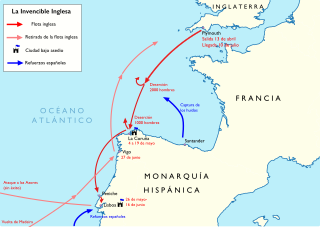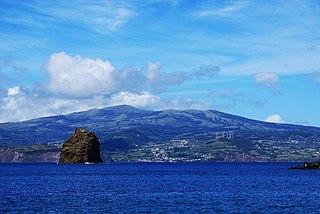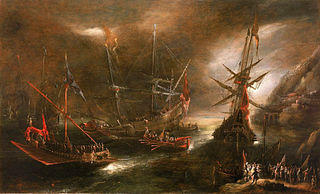
Galleons were large, multi-decked sailing ships developed in Portugal and Spain and first used as armed cargo carriers by Europeans from the 16th to 18th centuries during the age of sail and were the principal vessels drafted for use as warships until the Anglo-Dutch Wars of the mid-1600s. Galleons generally carried three or more masts with a lateen fore-and-aft rig on the rear masts, were carvel built with a prominent squared off raised stern, and used square-rigged sail plans on their fore-mast and main-masts.
Vice-Admiral Sir William Monson was an English admiral and politician who sat in the House of Commons in 1601.

The Battle of the Downs took place on 21 October 1639, during the Eighty Years' War. A Spanish fleet, commanded by Admiral Antonio de Oquendo, was decisively defeated by a Dutch force under Lieutenant-Admiral Maarten Tromp. Victory ended Spanish efforts to re-assert naval control over the English Channel and confirmed Dutch dominance of the sea lanes, while it is also alleged to be the first major action to feature line of battle tactics.

The Anglo-Spanish War (1585–1604) was an intermittent conflict between the Habsburg Kingdom of Spain and the Kingdom of England that was never formally declared. It began with England's military expedition in 1585 to what was then the Spanish Netherlands under the command of the Earl of Leicester, in support of the Dutch rebellion against Spanish Habsburg rule.

The English Armada, also known as the Counter Armada or the Drake–Norris Expedition, was an attack fleet sent against Spain by Queen Elizabeth I of England that sailed on 28 April 1589 during the undeclared Anglo-Spanish War (1585–1604) and the Eighty Years' War. Led by Sir Francis Drake as admiral and Sir John Norris as general, it failed to drive home the advantage that England had gained resulting from the failure of the Spanish Armada in the previous year. The Spanish victory marked a revival of Philip II's naval power through the next decade.

The naval Battle of Vila Franca do Campo, also known as Battle of Ponta Delgada and Naval Battle of Terceira Island, took place on 26 July 1582, off the coast of the island of São Miguel in the Portuguese archipelago of the Azores, during the War of the Portuguese Succession. A combined corsair expedition, mainly French, sailed against a Spanish naval force made up of Portuguese and Castilian ships, to preserve control of the Azores under the pretender António, Prior of Crato and to defend the islands from incorporation into the Iberian Union, the largest French force sent overseas before the age of Louis XIV.

The Spanish Armada was a Spanish fleet that sailed from Lisbon in late May 1588, commanded by the Alonso de Guzmán, Duke of Medina Sidonia, an aristocrat without previous naval experience appointed by Philip II of Spain. His orders were to sail up the English Channel, join with the Duke of Parma in Flanders, and escort an invasion force that would land in England and overthrow Elizabeth I. Its purpose was to reinstate Catholicism in England, end support for the Dutch Republic, and prevent attacks by English and Dutch privateers against Spanish interests in the Americas.

The Battles of La Naval de Manila or Battle of Manila Bay were a series of five naval battles fought in the waters of the Spanish East Indies in the year 1646, in which the forces of the Spanish Empire repelled various attempts by forces of the Dutch Republic to invade Manila, during the Eighty Years' War. The Spanish forces, which included many native volunteers, consisted of two, and later, three Manila galleons, a galley and four brigantines. They neutralized a Dutch fleet of nineteen warships, divided into three separate squadrons. Heavy damage was inflicted upon the Dutch squadrons by the Spanish forces, forcing the Dutch to abandon their invasion of the Philippines.

The Battle of Orbetello, also known as the Battle of Isola del Giglio, was a major naval engagement of the Franco-Spanish War of 1635. It was fought on 14 June 1646 off the Spanish-ruled town of Orbetello, on the coast of Tuscany, Italy, between a French fleet led by Admiral Armand de Maillé, Marquis of Brézé, and a Spanish fleet commanded by Miguel de Noronha, 4th Count of Linhares sent to break the blockade of Orbetello and relieve the town, besieged since 12 May by a French army under the command of Prince Thomas of Savoy. The Battle of Orbetello was tactically very unusual, since it was fought by sailing ships towed by galleys in a light breeze.
The action of San Mateo Bay or action of Atacames Bay was a naval engagement which took place from 29 June to 1 July 1594 between the galleon Dainty under the command of English privateer Richard Hawkins and a Spanish squadron of three galleons commanded by Beltrán de Castro at the mouth of the Esmeraldas river, nowadays Ecuador.

The Battle of the Gulf of Cádiz was a naval action which occurred on 7 August 1604, during the last days of the Anglo-Spanish War (1585–1604). The battle took place when a flotilla of two galleons commanded by Antonio de Oquendo engaged two English privateers who were plundering shipping lanes and villages around the Gulf of Cádiz. One of the English ships was captured and the other damaged. Oquendo's action off Cádiz is notable for having been fought just 21 days before the signing of the Treaty of London, which ended the protracted war between England and Spain.

The Battle of Sesimbra Bay was a naval engagement that took place on 3 June 1602, during the Anglo-Spanish War. It was fought off the coast of Portugal between an English naval expeditionary force sent out with orders by Queen Elizabeth I to prevent any further Spanish incursions against Ireland or England itself. The English force under Richard Leveson and William Monson met a fleet of Spanish galleys and a large carrack at Sesimbra Bay commanded by Álvaro de Bazán and Federico Spinola. The English were victorious in battle, sinking two galleys, forced the rest to retreat, neutralized the fort, and captured the carrack in what was the last expedition to be sent to Spain by orders of the Queen before her death the following year.

The Action of Faial or the Battle of Faial Island was a naval engagement that took place on 22–23 June 1594 during the Anglo-Spanish War in which the large and richly laden 2,000-ton Portuguese carrack Cinco Chagas was destroyed by an English fleet after a long and bitter battle off Faial Island in the Azores. The carrack, which was reputedly one of the richest ever to set sail from the Indies, was lost in an explosion which denied the English, as well as the Portuguese and Spanish, the treasure.

The Blockade of Western Cuba, also known as the Watts' West Indies Expedition of 1591, was an English privateering naval operation that took place off the Spanish colonial island of Cuba in the Caribbean during the Anglo–Spanish War. The expedition along with the blockade took place between May and July 1591 led by Ralph Lane and Michael Geare with a large financial investment from John Watts and Sir Walter Raleigh. They intercepted and took a number of Spanish ships, some of which belonged to a Spanish plate convoy of Admiral Antonio Navarro, and protected by the Spanish navy under Admiral Diego de la Ribera intending to rid English privateers. The English took or burnt a total of ten Spanish ships including two galleons, one of which was a valuable prize. With this success and the loss of only one ship the blockade and expedition was terminated for the return to England. The blockade was one of the most successful English expeditions to the Spanish Main during the war militarily and financially.

The Battle of Cape St. Vincent was a naval engagement that took place on 16 June or 6 October 1606, during Eighty Years' War and Dutch–Portuguese War. A Spanish fleet under Admiral Luis Fajardo attacked the Dutch fleet led by Admiral Willem Haultain and Vice Admiral Regnier Klaazoon, which was blocking the Spanish-Portuguese coast to intercept the Spanish treasure fleet. The battle concluded in a Spanish victory; in which Klaazoon's flagship was destroyed, two ships were captured, and Haultain fled with the rest of the fleet to his country without having achieved his purpose.

The Capture of the galleon Lion Couronné was a naval engagement that took place off Formentera on 17 June 1651, during the Franco-Spanish War (1635–1659). A squadron of eleven Spanish galleys under John of Austria the Younger captured the French galleon Lion Couronné after a fight.

Dainty was an English race-built galleon that began to be built in 1588. The original name was Repentance, but this was soon changed. It participated in some naval engagements in the Anglo-Spanish War (1585–1604). In 1593 it sailed from England under Richard Hawkins to navigate the Pacific Ocean and circumnavigate the world, but was captured the following year by the Spaniards when it was sailing off the coast of what is now Ecuador. It was commissioned by the Spaniards as Nuestra Señora de la Visitación, serving in the South Pacific for several years.
Luis Fajardo y Ruíz de Avendaño,, known simply as Luis Fajardo, was a Spanish admiral and nobleman who had an outstanding naval career in the Spanish Navy. He is considered one of the most reputable Spanish militaries of the last years of the reign of Philip II and the reign of Philip III. He held important positions in the navy and carried out several military operations in which he had to fight against English, Dutch, French and Barbary forces in the Atlantic, the Caribbean and the Mediterranean. He is known for the conquest of La Mamora in 1614.

The Brittany Campaign, or the Campaign of Brittany, was a military occupation of the Brittany, France, by Spain. It began in summer 1590 when Philippe-Emmanuel de Lorraine, Duke of Mercœur, the governor of Brittany, offered the port of Blavet to King Philip II of Spain so that he could harbour his fleet. The occupation formally ended on May 2, 1598, with the Peace of Vervins.
















